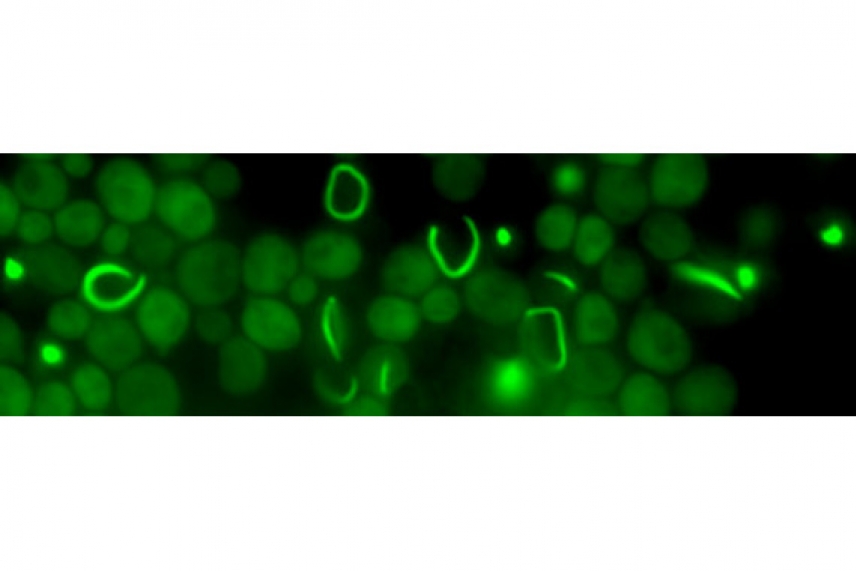A different tune: cellular IPOD plays role in prion biology

Microscope image of the transitional phase of yeast prions
J. Tyedmers, et al., PNAS, 2010 May 11;107(19):8633-8
CAMBRIDGE, Mass. – Cells take advantage of a biologically ancient compartment to sequester prions, an action that can initially prevent the prions’ phenotypic expression, according to Whitehead Institute researchers. While in this compartment, less heritable prion plaques mature to a more transmissible state.
“A transitional state for prions, when a prion is not heritable and infectious, has been suggested before, but it was not known that this transition state is already the true prion conformation, because it was hard to imagine how something could already be the prion conformation, but not yet have the traits of a true prion -- infectivity, heritability, and ability to create a phenotype.” says Jens Tyedmers, a former postdoctoral researcher in the lab of Whitehead Member Susan Lindquist. “This is the first time anyone has really demonstrated the nature of this transitional state and how it works.”
This research is reported by Tyedmers in this week’s early online edition of the journal PNAS.
Prions are a type of misfolded protein that can convert normal copies of that protein to a misfolded shape. As the misfolded copies accumulate in a cell, they stick together to form a long chain or clump in the cell. Although best known for causing neurodegenerative diseases such as Creutzfeldt-Jakob disease (CJD) in humans, bovine spongiform encephalopathy (BSE, or “mad cow disease”) in cows, and scrapie in sheep, prions can and do exist naturally in many organisms, including yeast. In yeast, prions can change a cell’s phenotypes for better or worse. And this can have important implications for the evolution of new traits in yeast.
By looking at prion-producing yeast cells, Tyedmers noted that both long prion chains and prion clumps were associated with a biologically ancient compartment called IPOD, for “insoluble protein deposit”. When Tyedmers first turned on prion production in the cells, long prion chains began in the IPOD, and then extended beyond the IPOD as ribbons, which were bounded by the cells’ membranes to form rings. After many generations, the ring form turned into prion clumps that look like dots in the cells. These dots were a hodgepodge of numerous, very short prion chains that remained confined within the IPOD.
Tyedmers and his colleagues believe that the IPOD serves as a depository for damaged and hopelessly misfolded protein aggregates, including prions. Eventually, these proteins may either be chopped up by the enzyme Hsp104 or remain contained in the IPOD until the cell dies. The IPOD may also retain problem proteins throughout cell division. As the original mother cell divides, an IPOD full of damaged and potentially harmful proteins remains in the mother cell, thereby allowing the daughter cell to begin life without the burden of potentially toxic proteins.
Yet, the IPOD does not prevent prion inheritance. Tyedmers found that the dot state is almost always passed from the original mother cell to its daughter cell, whereas the ring state is less frequently passed to the daughter cells. This difference in heritability combined with the eventual conversion from ring form to dot form over many generations suggests that the ring form is a transitional prion state.
Sebastian Treusch, who is second author on the paper, explains that the Hsp104 enzyme is responsible for the inheritance of both prion forms and plays an important role in the conversion of rings to dots.
“The enzyme chops up long prion fibers into shorter fibers, at some rate generating little specks of prion, or prion seeds, that can freely diffuse into the future daughter cell,” says Treusch. “The ring state has longer prion fibers. This makes them less heritable as they are more easily captured in the mother cell.”
“This means the prion has evolved to escape the damage retention in the mother,” says Tyedmers. “This works most efficiently when the cleavage rate is very high, as in the dot form’s case.”
According to Lindquist, who is also a professor of biology at MIT and a Howard Hughes Medical Institute Investigator, the IPOD has been evolutionarily retained from yeast through higher organisms. Therefore, the results of this study may have broader implications for understanding the cellular mechanisms of prion organization and the retention of damaged proteins.
This research was supported by the National Institutes of Health (NIH), the European Molecular Biology Organization (EBMO), the Human Frontiers Science Program (HFSP), and the American Heart Association.
* * *
Susan Lindquist’s primary affiliation is with Whitehead Institute for Biomedical Research, where her laboratory is located and all her research is conducted. She is also a Howard Hughes Medical Institute investigator and a professor of biology at Massachusetts Institute of Technology.
* * *
Citation:
Tyedmers, J., Treusch, S., Dong, J., McCaffery, J. M., Bevis, B., & Lindquist, S. (2010). Prion induction involves an ancient system for the sequestration of aggregated proteins and heritable changes in prion fragmentation. Proceedings of the National Academy of Sciences, 107(19), 8633-8638.
Contact
Communications and Public Affairs
Phone: 617-452-4630
Email: newsroom@wi.mit.edu


